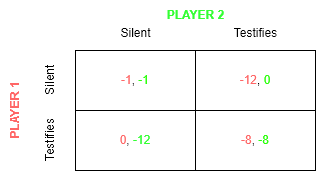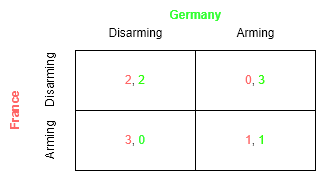Game Theory
What is Game Theory?
Game theory is a social science approach used to analyze the interactions between individuals or groups in strategic situations, particularly in the context of cooperation and conflict. It is a rational and structural approach that seeks to understand the choices and strategies of actors in a given situation.
Game theory models are often used to analyze the dynamics of cooperation and conflict between states, where each state has two choices: cooperate or defect from the other. The approach is based on the assumption that actors are rational and self-interested, and seeks to identify the optimal strategies for achieving their goals. The intersection of realism and game theory has been used to analyze the challenges and possibilities of cooperation in international politics, particularly in the context of anarchical systems and the security dilemma.
Concept From Game Theory
- Cooperation and defection
- Defensive and offensive
- The nature of power
- Perceptions, values, and self-interest
- Psychological impediments to cooperation
Prisoner’s Dilemma
The Prisoner’s Dilemma is a concept in game theory that illustrates a situation in which two rational individuals might not cooperate, even if it is in their best interest to do so.
For example, imagine in this dilemma, two suspects are arrested and held in separate cells, and the authorities lack the evidence to convict them on a major charge. They offer each prisoner a deal to testify against the other:
- If one testifies and the other remains silent, the silent one gets the full prison sentence, and the other goes free; Assume that those who don’t confess will be jailed for 12 months.
- If both testify, they both receive a reduced sentence; Assume, both of them were sentenced to 8 months in prison.
- If neither testifies, they both get a moderate sentence; Assume, each will get 1 month in prison.
- Assume that the two suspects don’t know each other, and they just want to minimize their time in prison. should they confess?

The dilemma arises because, while the best outcome for the individuals as a whole is for both to remain silent, each prisoner has an incentive to testify, as it offers a better individual outcome regardless of the other’s choice.
The outcomes of the Prisoners’ Dilemma game are as follows:
- Both players choose to defect (DD): Mutually preferable. The concept of a “reasonable outcome” in the context of the Prisoner’s Dilemma game refers to a result that is mutually preferable for all parties involved. The moderate sentence outcome is considered the most reasonable, as it is the only outcome in which both players receive a better outcome
- One player chooses to defect and the other chooses to cooperate: The defector benefits from the cooperation of the other, receiving a reduced sentence, while the cooperative player receives the full prison sentence.
- Both players choose to cooperate (CC): Reasonable outcome. “Reasonable outcome” in the context of the Prisoner’s Dilemma game refers to a result that is mutually preferable for all parties involved. In this outcome, both players receive a reduced sentence.
“What makes this configuration disturbing is that even if each side prefers CC to DD (and each knows that this is the other’s preference) the result can be DD because each is driven by the hope of gaining its first choice - which would be to exploit the other (DC) and its fear that, if it cooperates, the other will exploit it (CD).” (Jervis, 1988).
Prisoner’s Dilemma in International Relation Context
The Prisoner’s Dilemma is often used as a theoretical framework to understand and analyze various situations in international relations. One classic example is the dilemma of arms races and disarmament. In this context, two or more states face the choice of either arming themselves (defecting) to ensure their security or disarming (cooperating) to reduce the risk of conflict and promote stability. If one state chooses to arm itself while the other disarms, the disarming state may be left vulnerable, resulting in a less favorable outcome. However, if both states engage in an arms race, it can lead to a situation where both are less secure and incur higher costs, representing a suboptimal outcome similar to the Prisoner’s Dilemma. This example illustrates how the dynamics of cooperation and conflict in international relations can be analyzed using the framework of the Prisoner’s Dilemma.
Example: Why states’ attack each other and make World War I?
Assumption
- The country’s leaders at the time believed in the power of weapons and offensive tactics
- Although all leaders prefer to make peace, no one wants to be attacked first
- First strike = advantage at war
World Condition
- In this world there are only two countries (for example, Germany and France)
- There are only 2 strategies in this game, namely arming themselves (defecting) or disarming (cooperating)
- Outcomes of the game:
- A state arming themselves and the other’s will disarming
- All states’ disarming (peace)
- All states’ arming themselves (lead to war)
- A state disarming and the other’s arming themselves

Because all countries don’t want to get attacked first, it is possible all actors will arming themselves because they want to take the advantages (if it leads to war)